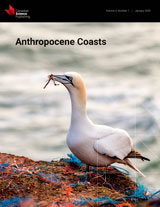Anthropocene Coasts
Anthropocene Coasts, an open access journal, publishes multidisciplinary research that aims to understand and predict the effects of human activities, including climate change, on estuarine and coastal regions. Anthropocene Coasts publishes original research articles, reviews (and overviews), topical communications, notes and letters.

The Anthropocene is the period during which human activities have had a marked, and often decisive, environmental impact on the Earth, whilst Coasts embraces all aspects of the land–sea interface.
Anthropocene Coasts therefore seeks to identify and document the influence of human activities on contemporary coastal processes (physical, biological, and chemical processes across the land–sea interface) and the implications for other aspects of these systems including social, economic, and legal considerations.
Special Collection Call for Papers:
Challenge and Resolution to the Threatened Anthropocene Coast
SUBMISSION DEADLINE: SEPTEMBER 1, 2022
Open access journal with waived APCs until December 31, 2024
Anthropocene Coasts publishes multidisciplinary research that aims to understand and predict the effects of human activities, including climate change, on estuarine and coastal regions.
This Special Collection encourages studies addressing a wide range of topics, including but not limited to:
Submission Instructions
GUEST EDITORS
- Qing He, Director of State Key Laboratory of Estuarine and Coastal Sciences, East China Normal University
- Hui Wu, State Key Laboratory of Estuarine and Coastal Sciences, East China Normal University
- Yaping Wang, State Key Laboratory of Estuarine and Coastal Sciences, East China Normal University
- Wenping Gong, Center for Coastal Ocean Science and Technology Research, School of Marine Sciences, Sun Yat-sen University
- Steven A. Kuehl, Chair of Department of Geological Oceanography, State Key Laboratory of Marine Environmental Science, Xiamen University
Latest Publication
Volume 5, 2022
Coastal erosion is widespread under conditions of changing hydrodynamics and diminishing sediment supply, and exposure assessment to erosion hazard has received increasing attention. In this study, we explore the impact of spatial heterogeneity of land use within administrative units on exposure assessment of land use value to erosional hazard.
Volume 5, 2022
Abstract Recent developments in process-based coastal area models such as XBeach provide new opportunities to predict coastal responses to primary forcing mechanisms such as storm hydrodynamic by using 2DH grids. However, due to the lack of measured data, there are few application scenarios of the models. Therefore, more measurement and research are needed. In this […]
Volume 5, 2022
Abstract Aquatic flexible vegetation plays a very important role in ecosystem, and has been widely used in river or coastal bank revetment. Flexible vegetation contributes to wave attenuation and soil retention. In this study, a fluid-structure bidirectional coupled numerical model (FSC model) was developed based on the codes in-house software HydroFlow@ to study the interaction between […]
Volume 5, 2022
Abstract Human development of mega-deltas is influenced by the elevation of delta ground surface. The elevation, modulated by the largest tidal range, influences the inundation pattern during storm surges, or the degree of risk in the presence of a sea dyke. However, the tidal modulation may be interrupted by nature or human induced subsidence or […]
Past Volumes

Volume 1

Volume 2

Volume 3





